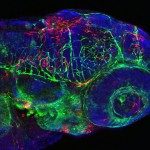Link to Pubmed [PMID] – 10852824
J. Cell. Sci. 2000 Jul;113 ( Pt 13):2455-62
It is generally assumed that the vimentin intermediate filament network present in most mesenchymally-derived cells is in part responsible for the strength and integrity of these cells, and necessary for any tissue movements that require the generation of significant tractional forces. Surprisingly, we have shown that transgenic KO mice deficient for vimentin are apparently able to undergo embryonic development absolutely normally and go onto develop into adulthood and breed without showing any obvious phenotype. However, fibroblasts derived from these mice are mechanically weak and severely disabled in their capacity to migrate and to contract a 3-D collagen network. To assess whether these functions are necessary for more challenging tissue movements such as those driving in vivo tissue repair processes, we have analysed wound healing ability in wild-type versus vimentin-deficient embryos and adult mice. Wounds in vimentin-deficient adult animals showed delayed migration of fibroblasts into the wound site and subsequently retarded contraction that correlated with a delayed appearance of myofibroblasts at the wound site. Wounds made to vimentin-deficient embryos also failed to heal during the 24 hour culture period it takes for wild-type embryos to fully heal an equivalent wound. By DiI marking the wound mesenchyme and following its fate during the healing process we showed that this impaired healing is almost entirely due to a failure of mesenchymal contraction at the embryonic wound site. These observations reveal an in vivo phenotype for the vimentin-deficient mouse, and challenge the dogma that key morphogenetic events occurring during development require generation of significant tractional forces by mesenchymal cells.

